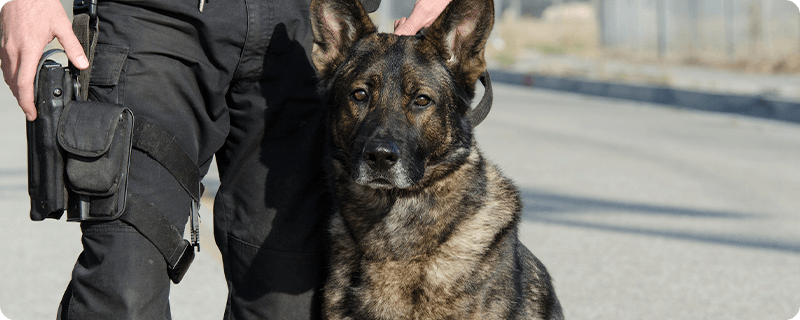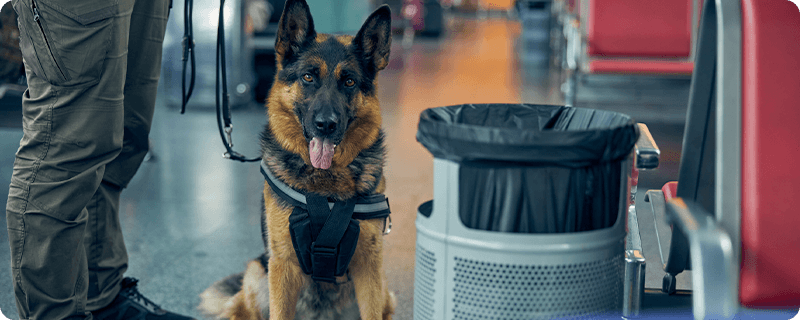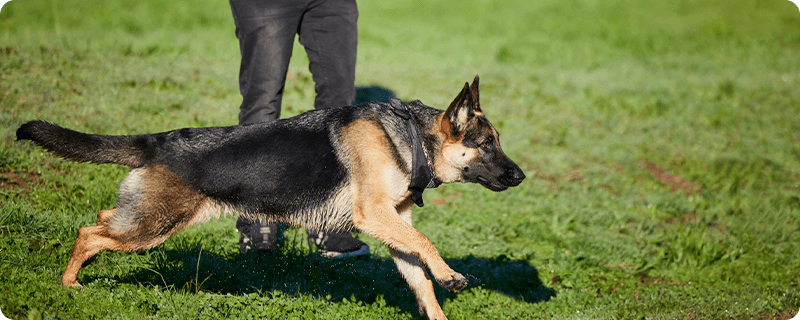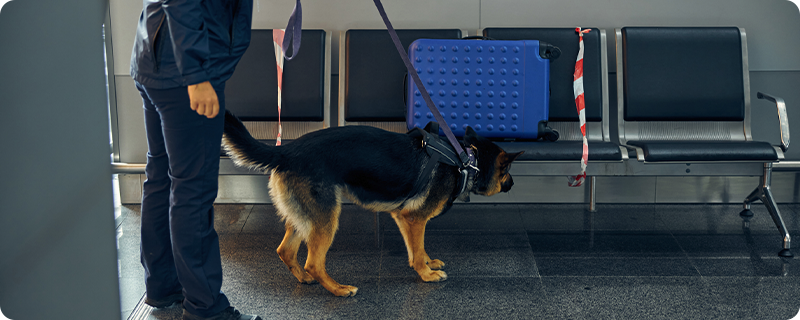Retail Security: Friendly K9 Dogs Increase Customer Safety and Deter Theft

K9 security dogs create an increase in the feeling that someone is in an atmosphere of safety for a facility’s customers and employees.
Retail Security: Friendly K9 Dogs Increase Customer Safety and Deter Theft
How do you deter (or lessen) theft in your retail environment while making your customers and employees feel safe? “Getting shoppers back into shopping centers will be impossible if they don’t feel safe. COVID-19 mitigation is a major part, but so is safety and security in a world of growing threats.” (Source) Current surveillance technology can be a great asset to protecting a business. But let’s face it . . . surveillance technology is reactive and passive.
The latest technology isn’t mobile and, at best, can only alert the police—not prevent a threat. Retail theft and threats to personal security are rapidly rising.
The statistics speak for themselves:
- Thefts at CVS are up 30% since the pandemic began.
- The Coalition of Law Enforcement and Retail estimates that organized retail theft accounts for around $45 billion in annual losses for retailers these days.
- More than two-thirds (69%) of respondents in the National Retail Security Survey released by the National Retail Federation said they’re seeing an increase in fraud, crime, and overall risk to their organization as a result of COVID-19.
(Source)
- Close to 69% of retailers have seen an increase in ORC (organized retail crime) activity in the past year.
- Almost two-thirds or 65% of respondents noted the increase in violence.
- And another 37% said ORC gangs were much more aggressive than in the past.
(Source)
- In the San Francisco Central district, for example, larceny and theft incidents are up almost 88% from a year earlier, and overall crime is up almost 52%, according to police statistics.
Surveillance technology is helpful in capturing what happened in the past; it doesn’t help prevent a threat. Here’s the question: Is there a way to deter or lessen a threat in a proactive way? This article shows retail owners, corporate store managers, property managers, and security directors how they can use K9 security dogs (also known as K9 protection dogs) and handlers to protect their property in a proactive way—not in a reactive way.
They will also discover how K9 security dogs create an increase in the feeling that someone is in an atmosphere of safety for a facility’s customers and employees. How do retailers typically deal with theft? They hire unarmed guards, armed guards, and off-duty police officers. Retailers also integrate technology: surveillance cameras and alarm systems.
While these technologies are helpful in identifying thieves, do these technologies really help prevent a theft in the first place? (Usually, they do not.) How effectively are these security approaches working? Let’s start with unarmed guards. How well-trained are your front guards? What will your front unarmed guards use to prevent serious thefts from happening?
A laptop?
A paper notebook?
A coffee cup?
You see the point I’m making, right? An unarmed guard has few or no defensive tools to circumvent a serious theft. Let’s talk about armed guards Armed guards have poor hit rates. Even if an armed guard could engage a threat, statistics show that a well-trained police officer has a 17%–43% hit rate. Can you imagine the poor hit rate of armed guards who don’t train nearly as much as professionally trained police officers?
According to Reveal News, “Men and women who have never fired a gun in their lives can set off on patrol in uniform, wearing a badge and carrying a loaded weapon, with only a few hours of training, if any. In 15 states, guards can openly carry guns on the job without any firearms training at all. The results can be as tragic as they are predictable.”
What about surveillance technology?
According to Forbes.com, “Allied Universal, a global security and facility services company, is arming retailers and mall owners with advanced technology using high-resolution video cameras to record activities throughout stores, malls, and parking areas in order to help identify suspects and record license plate numbers. It uses video analytics to gauge people’s behavior in order to provide instant alerts to authorities for suspicious actions. And social media platforms can be monitored using specific keyword analytics to assess potential organized attacks.
“Brian Neimeyer, Allied’s senior vice president of its retail division, doesn’t discount the value of uniformed security officers to deter crime, but says more is needed.” (Source)
What is the alternative solution?
The alternative solution is K9 security dogs with handlers.
What is K9 security (or K9 protection)?
K9 security involves using canines to prevent issues from happening by their mere presence, by engaging in behaviors that range from barking at the subject to biting, in the worst-case scenario. The presence of canines also serve as a psychological deterrent to would-be criminals and disgruntled employees. The intruder becomes the prey (instead of the staff or employees becoming the prey). Canine security can replace traditional security measures and equipment, but it doesn’t have to; it can be used as an additional layer of security.
How are K9 protection dogs different from police canines?
Police dogs are trained to go after dangerous threats or subjects. They are built to take down a threat immediately. They have a high-drive defensive disposition (which means they might be less social). K9 X-Factor protection dogs are not looking for action or to take down a subject, but they can if they are called upon to do so. Our dogs have one prime mission: to help prevent dangers from happening in the first place. K9 X-Factor dogs are calmer; they’re only looking to prevent a threat. Our dogs crave positive human attention, including being pet, just as much and as often as your family pet does. But they can turn on their “on switch” to get into defense mode when called upon.
How do K9 security dogs increase customer safety?
Trained security canines are more effective at securing the premises to which they are assigned than people or machines because of their senses of smell and hearing. They can detect strange noises and unusual odors. When a trained security canine hears or smells gunfire, it can detect the origin of the gunfire more accurately than humans can. In 2010, after spending six years and $19 billion on research to develop better bomb-detecting technology, Pentagon officials admitted that dogs’ noses were still superior to their most sophisticated technology. (Source) Additionally, compared with bomb-detecting robots, dogs are more mobile. Surveillance cameras, on the other hand, are stationary, limiting their range of view and the type of activity captured. Steve Edwards, CoxHealth president and CEO, implemented a security strategy using two highly trained German shepherds to help with public safety in the hospital.
Edwards said the benefits of the dogs are twofold:
“First off, they act as therapy dogs of sorts, putting many people at ease by their mere presence. Secondly, he said the dogs are trained to defend staff and patients if necessary. People kind of understand that a dog won’t back down from a knife or a gun where a person might.”
The dogs have been used at CoxHealth for at least the past six months, and Edwards said the return on their investment has been positive, with an appreciable reduction in the number of times people needed to be restrained.
How do K9 security dogs deter theft?
While we wait for statistics related to K9 security and retail theft to be reported . Just ask a convicted burglar how dogs can deter theft at a home. An investigative report by KGW8 out of Oregon surveyed 86 inmate burglars. The study concluded that if “a homeowner had a big, loud dog, most burglars would stay away.”
One of the convicted burglars even said, “Dogs are a deal breaker for me… Big breeds—home protectors—are the best to keep people out.”
According to statistics on the National Center for Biotechnology Information website, canines have effectively reduced crime and violence by 75%–80% in Midwest and East Coast hospitals where they’re used. And “a second study in Yarmouth, Massachusetts, showed a dramatic 80% decrease in commercial break-ins following the first year of a canine unit being on patrol and aggressively addressing the issue of the break-ins.”
What are the key benefits of K9 security dogs?
Benefit 1: A K9 security team is mobile, highly responsive, and a visual deterrent to any perpetrator.
The biggest advantage of having a K9 security team is that it can respond at every level in the “use of force” continuum—in just seconds. Take a look at the use-of-force continuum chart: The canine can respond up or down the continuum, within seconds, depending on the perpetrator’s actions.
Benefit 2: Canines are useful in a wide variety of situations
Security directors and administrators are looking for additional security solutions because the standard protocols aren’t working. Security canines can cover a large space quickly due to their speed and mobility. In fact, one canine can cover as much territory as four to five security guards. Metal detectors, surveillance systems, and the like are great, but they’re passive. A thief, who is intent on stealing, can avoid surveillance detection.
When things come down to a matter of seconds . . . what will happen?
How are you going to counteract the threat?
Benefit 3: Security canines are safe to be around
Only one out of every 10 dogs will pass the test needed to work in a variety of social environments. These dogs must accept being pet by a wide range of people and must not react aggressively, but they also must be ready to go into a defensive mode when the situation warrants. K9 teams do not use typical police dogs, which tend to be less social.
Do K9 security dogs bite people?
You might be wondering about the liability of dogs biting people. The simple answer is these canines won’t bite unless it’s a life-threatening situation. The canines I use in schools, hospitals, and corporations are raised and trained both to be people-friendly and to go into a defense mode as the need arises. Trained security canines are not your typical police dogs, which are trained to be defensive.
The security canines my company uses come from Eastern Europe, including the Czech Republic and Slovakia. Most are German shepherds, but some are Belgian Malinois. The dogs from these areas have a solid nerve threshold, and you can rely on them to keep you safe. These dogs have a special temperament that allows them to deal with the public 24 hours a day. The dogs at K9 X-Factor have been tested in all capacities and have nerves of steel. They can be trusted with children and are never bullying or dominant. They have nothing to prove because they know they can handle any security situation that should arise.
Summary
I began this article asking retail owners, corporate store managers, property managers, and security directors one critical question: How do you deter (or lessen) theft in your retail environment while making your customers and employees feel safe?
We know surveillance technology is helpful in capturing what happened in the past, but it doesn’t help prevent a threat. Numerous studies have shown how K9 security dogs and handlers can protect property and people in a proactive way—not in a reactive way.
Is there a way to deter or lessen a threat in a proactive way?
Yes, there is! With K9 security teams.






